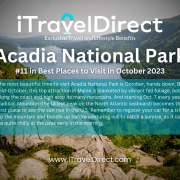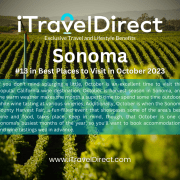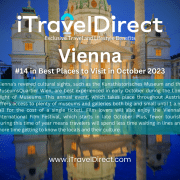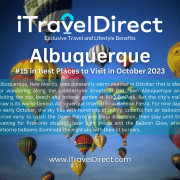Acadia National Park #11 in Best Places to Visit in October 2023
Why Go To Acadia National Park
Vacationing in Acadia National Park turns you into a pioneer: Each trail leads to rugged, untouched land just waiting to be captured by your camera lens. Cobalt waves crash on the jagged granite slabs topped with spruce trees that jut out from the shore. Harbor seals sun themselves on abandoned chunks of bedrock off the coast as peregrine falcons scream down at you from the skies. Rocky trails and rustic carriage roads thread around the inland trees and ponds, begging for exploring. Needless to say, the park is for your typical outdoor enthusiast, with a huge focus on adrenaline-pumping activities like horseback riding, biking, hiking – even rock climbing.
For a very affordable fee, you’re given free rein to explore Acadia’s more than 47,000 acres, including all of its hiking trails and natural attractions. When you need a break from the great outdoors, the quaint New England town of Bar Harbor, Maine, waits for you in the northeast corner of Mount Desert Island.
Best Months to Visit
The best time to visit Acadia National Park is September through early October, after the summer crowds have left but before the temperatures drop below freezing. Visiting in March, April and May can be soggy – fog and rain are common – so you’ll need to pack your waterproof gear. The weather is pleasant come July and August, but it’s by far the most crowded season for the park. The park doesn’t see many visitors in winter, but it’s the perfect time to visit for the dedicated adventure traveler ready to brave the freezing temperatures.
What to Eat
While there aren’t many dining options within Acadia National Park, nearby Bar Harbor, Maine, is chock-full of quaint eateries and bars. Of course, lobster is a must-try dish in Maine, and you’ll find some of the best at Beal’s Lobster Pier, Thirsty Whale Tavern and Galyn’s. Many visitors also recommend the blueberry pancakes and pies from Café This Way and Jeannie’s Great Maine Breakfast. If you would rather pack a picnic lunch for your day in the park, stop at one of the few grocery stores downtown or grab a sandwich from a casual shop like Downeast Deli and Boxed Lunch Co. Keep in mind many Bar Harbor restaurants operate seasonally, so be sure to check the hours and closures before you go.
The only restaurant within the park is Jordan Pond House Restaurant, which overlooks Jordan Pond. The restaurant is famous for its afternoon tea, popovers and seafood. However, be prepared for long waiting times as it’s usually crowded.
Getting Around Acadia National Park
The best way to get around Acadia National Park is on foot. With 158 miles of historic trails made for hiking, Acadia is the perfect place to ditch the car and get outdoors. To reach the park, you can hop on the Island Explorer, a free summer shuttle service that transports passengers from Bar Harbor Village Green to a variety of park destinations. Should you prefer your own set of wheels, you can rent a car at one of the nearby airports, including Bangor International Airport (BGR), located just an hour’s drive northwest of the park, and Hancock County-Bar Harbor Airport (BHB), located about 10 miles north of Acadia. Guided tours and ranger-led programs are also available.
On Foot
Walking along the park’s 45-mile carriage road system is the best way to experience the park’s awe-inspiring scenery. For a serene and easy hike, try the Wonderland Trail, which features a lush forest and a rocky ocean views. For a more challenging climb, check out Acadia’s Beehive Trail, which boasts gorgeous vistas, but requires a strenuous hike up steep iron rungs on ledges of exposed cliffs. Novice hikers should only tackle these trails in the spring, summer and early fall when the weather permits a leisurely stroll. Winter hiking is only advised for experienced trekkers.
Bus
The Island Explorer, a fare-free summer bus service, offers 10 bus routes connecting Acadia’s hotels, trails, campgrounds and village centers on Mount Desert Island. Featuring all-propane-powered vehicles, Island Explorer’s environmentally friendly buses will not only drop you off at your desired stop upon request, but will also save you the hassle of trying to find a space in congested parking areas. Bus routes are currently in operation from June 23 through Columbus Day (early October), with a reduction in service in late August. You can find maps and timetables on the official Island Explorer website.
Car
A car is resourceful if you’re planning to visit a variety of attractions within the park. You can drive the nearly 30-mile Park Loop Road if you’re hoping to find spectacular views of Acadia’s ocean, mountains and forests. There are also many observation points where you can stop the car and admire the scenery. Another must-drive spot: Cadillac Mountain, a winding 3 1/2-mile road that features dazzling scenery of the park’s tallest mountain. Keep in mind: Main roads close during the winter, so it’s best to check ahead if you’re planning to visit during this offseason. You can rent a car from any of the airports surrounding the park. Bargain-hunters beware: Bringing a vehicle will set you back $30 (as opposed to the $15 you would pay as a pedestrian, hiker or biker). For tips on navigating the park via car, visit the National Park Service website.
Start Saving with iTravelDirect’s Exclusive Travel and Lifestyle Benefits Membership
CLICK HERE to Test-Drive our Guaranteed Savings
We offer a 110% Price Guarantee – Find a lower price anywhere online and we will refund you 110% of the difference.
CLICK HERE for a full list of services and Membership Discounts.
When you join iTravelDirect, you’ll have full access to all club benefits.
Your membership gives you the freedom to travel when you want, to where you want.
And you won’t find lower rates anywhere, guaranteed. So, pack your bags and start planning that vacation of a lifetime today!





